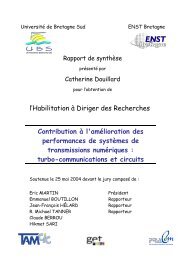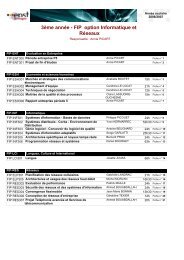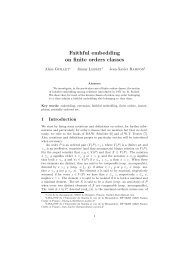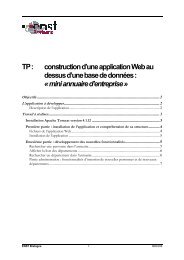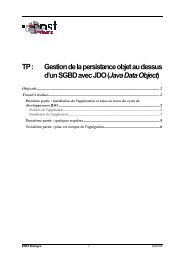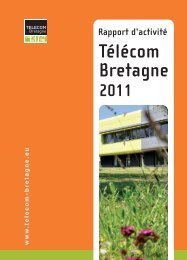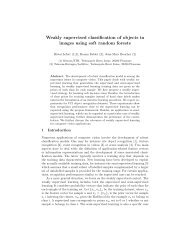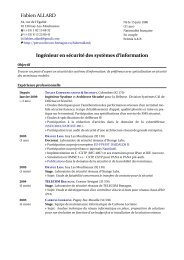researResearch - Télécom Bretagne
researResearch - Télécom Bretagne
researResearch - Télécom Bretagne
You also want an ePaper? Increase the reach of your titles
YUMPU automatically turns print PDFs into web optimized ePapers that Google loves.
esearc<br />
<strong>researResearch</strong><br />
30<br />
• Atmospheric probing using GNSS<br />
This study carried out under the CNES (Centre<br />
national d’études spatiales) in collaboration with the<br />
LaMP (Laboratoire de Métrologie Physique) of<br />
Clermont-Ferrand University aims to validate the<br />
precision of measurements of pseudo-distances<br />
possible with Galileo in order to allow performance<br />
simulation of the system for atmospheric probing.<br />
In this study, we evaluated the effect of 2 and 3 order<br />
ionospheric terms using archived data. Reception<br />
from the Giove A satellite was set up in 2008, with<br />
the help of a Septentrio receiver. This work, which<br />
was completed at the end of 2008 demonstrated a<br />
growing precision provided by Giove for measuring<br />
pseudo-distances. This increased precision,<br />
resulting from the transmission of highperformance<br />
pseudo-random codes, allows us to<br />
envisage more ambitious corrections of ionospheric<br />
effects<br />
• Prediction of ionospheric scintillation (PRIS)<br />
ARTES-5<br />
This is an ESA contract in partnership with IEEA, in<br />
which IETR 3 , DLR 4 (Germany) and GMV 5 (Spain)<br />
participate. Télécom <strong>Bretagne</strong> is responsible for a<br />
GPS scintillation monitor in Vietnam. The study of<br />
ionospheric scintillations, which are particularly<br />
intense in equatorial regions, constitutes a major<br />
challenge for the availability and integrity of the<br />
future GNSS. The acquisition of scintillations<br />
measurements from Vietnam took place during the<br />
period 2006-2008. Initial observations seemed to<br />
show behavioural differences between the Southeast<br />
Asian ionosphere and that of South America.<br />
ESA activity ended in August 2008 with a final<br />
written report. This study allowed to refine the<br />
techniques of data-processing of scintillations and<br />
to compare scintillations recorded at various points<br />
of the globe, located in equatorial and polar zones,<br />
with predictive models. This comparison showed<br />
that the models studied can be considered<br />
satisfactory from a statistical point of view but do not<br />
allow a viable short-term forecast of a particular<br />
event.<br />
3) IETR : Institut d’électronique et de télécommunication de Rennes<br />
4) DLR : Deutsches Zentrum für Luft<br />
5) GMV :<br />
• GPS - GALILEO<br />
Part of the work of the TIME team of UMR CNRS<br />
TAMCIC concentrates on characterising GPS type<br />
signals that are quite sensitive to interferences from<br />
other radar systems and are consequently sensitive<br />
to various and different interferences. The aim of<br />
this study was to analyse from a theoretical point of<br />
view (study paper) and a practical (experimentbased)<br />
point of view the performance of a bi-static<br />
SAR system available satellite transmission<br />
opportunities (GPS). This work is linked to a study<br />
carried out under an ONERA contract. Besides, one<br />
contract has been validated in a Europôle Mer<br />
project. This project (MPOS : Marine Opportunity<br />
Passive Systems) aimed to characterise and<br />
measure the GPS/GALILEO signal which was<br />
returned from the sea surface – comparing it with a<br />
direct signal – extracting information about sea<br />
surface agitation and currents.<br />
At the same time, the GalileOcean project, labelled<br />
Pôle Mer, was redefined in order to be able to use<br />
the data and the results obtained by the acquisation<br />
platform developed in the CapSys project.<br />
• HF SATIS propagation software<br />
A study aimed at improving the SATIS ionospheric<br />
propagation forecast software was carried out in<br />
2008 under a THALES Communications contract.<br />
This study aimed at allowing SATIS to be used as<br />
embedded software in MELCHIOR, the real-time HF<br />
communications management system.<br />
Studies and experiments concerning the<br />
characterisation and modelling radio-electric<br />
propagation channels principally concerned:<br />
• Advanced study of the effect of antennae on radio<br />
channels<br />
The innovative RNRT project RADIC-SF allowed<br />
developing a transverse approach between wave,<br />
signal domains, and protocols for the study of<br />
configurations of wireless networks of diverse<br />
cooperation. For this, the quality in the transmission<br />
channel modelling is a challenge of prime<br />
importance for traffic simulators from which<br />
efficient network strategies will be validated. At both<br />
ends of the channel, antennae have a key role, in the<br />
context of MIMO architecture. From a fundamentally<br />
deterministic approach, and in continuity with<br />
previously developed CAPSYS study (particularly<br />
EPAR-3D), work concentrated on a good<br />
understanding of the propagation channels<br />
associated with these new networks. During the<br />
first phase, pertinent statistical parameters for<br />
modelling VHF, UHF and SHF band channels of<br />
radio-electric communication were identified. This<br />
was done on the basis of rigorous modelling<br />
founded on an asymptotic approach to wave<br />
propagation (the uniform theory of diffraction and<br />
automatic ray calculation). The acquisition in 2008<br />
of the WinProp software very effectively reinforced



